Phone calls are a critical part of healthcare communication, but they also pose significant risks to patient privacy. HIPAA compliance during phone calls is essential for protecting sensitive medical information and avoiding costly penalties.
At ScriberJoy, we understand the challenges healthcare providers face in maintaining HIPAA compliance while efficiently handling patient calls. This guide will explore practical strategies and technological solutions to help you safeguard patient data during phone conversations.
What Are HIPAA’s Phone Call Requirements?
The Health Insurance Portability and Accountability Act (HIPAA) sets strict standards for protecting patient information, including during phone calls. Healthcare providers must navigate these regulations carefully to maintain compliance and avoid hefty penalties.
The HIPAA Privacy Rule and Verbal Communication
The HIPAA Privacy Rule governs how Protected Health Information (PHI) should be handled, including verbal communications. For phone calls, healthcare providers must take specific precautions to safeguard patient data. These precautions include:
- Verifying the identity of callers
- Limiting the information shared
- Ensuring conversations occur in private settings
The U.S. Department of Health and Human Services reported that in 2023, they resolved 13 HIPAA violation cases. Many of these violations stemmed from improper handling of patient information, including during phone conversations.
Specific Regulations for Phone Communications
HIPAA doesn’t explicitly prohibit sharing PHI over the phone, but it requires reasonable safeguards. Healthcare providers should use secure phone lines and avoid discussing sensitive information in public spaces where others might overhear.
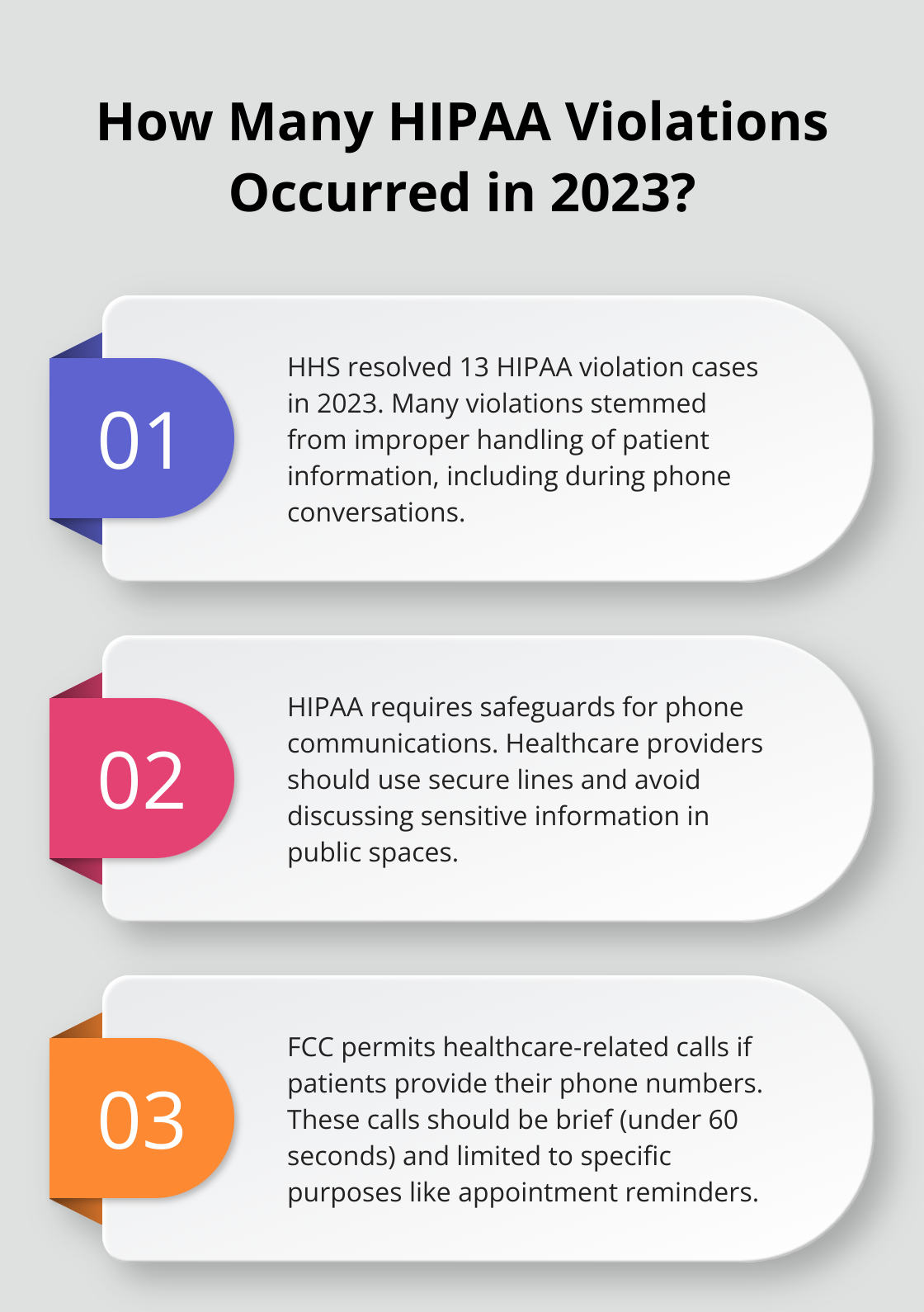
The Federal Communications Commission (FCC) has clarified that healthcare-related calls are permitted if the patient has provided their phone number to the covered entity. However, these calls should:
- Be brief (ideally under 60 seconds)
- Be limited to specific purposes (e.g., appointment reminders or sharing test results)
Protecting Patient Information: A Critical Responsibility
Protecting patient information during calls isn’t just a legal requirement-it’s a critical aspect of maintaining patient trust and providing quality care. A breach of confidentiality can have severe consequences (both for the patient and the healthcare provider).
To mitigate risks, healthcare organizations should implement robust training programs for staff handling phone calls. This training should cover:
- Proper identity verification procedures
- Guidelines for sharing information
- Protocols for handling potential breaches
Leveraging Technology for HIPAA Compliance
Technology can significantly enhance HIPAA compliance during phone calls. Healthcare providers should consider implementing:
- Encrypted phone systems
- Secure voicemail services
- Call recording software
These tools play a crucial role in protecting sensitive information and maintaining an audit trail of communications.
As we move forward, it’s important to understand that HIPAA compliance during phone calls is an ongoing process. It requires constant vigilance, regular training, and the right technological solutions. In the next section, we’ll explore best practices for ensuring HIPAA-compliant phone conversations in more detail.
How to Safeguard Patient Information During Phone Calls
Implement Rigorous Identity Verification
Always verify the caller’s identity before sharing any patient information. This process should involve more than just asking for a name. Request specific identifiers such as date of birth, address, or the last four digits of their Social Security number. For added security, implement a system where patients create a unique PIN or passphrase during their first visit, which they must provide during future phone interactions.
Use Secure Communication Channels
Protect sensitive information from interception by using encrypted phone lines. VoIP systems with end-to-end encryption offer a higher level of security compared to traditional landlines. When discussing patient information, ensure you’re in a private area where conversations can’t be overheard. If you work remotely, use a noise-cancelling headset to minimize the risk of others overhearing sensitive details.
Minimize Information Disclosure
Adhere strictly to the HIPAA Minimum Necessary Standard. Only disclose the information essential for the specific purpose of the call. For instance, when confirming an appointment, don’t mention the nature of the visit. Train your staff to recognize what information is necessary and what should be omitted during phone conversations.
Provide Comprehensive Staff Training
Conduct regular, in-depth training sessions on HIPAA compliance and proper phone etiquette. These sessions should cover:
- Proper greeting and identification procedures
- How to handle difficult situations (e.g., when a caller becomes angry or demands information you can’t provide)
- The importance of documenting all phone interactions in the patient’s record
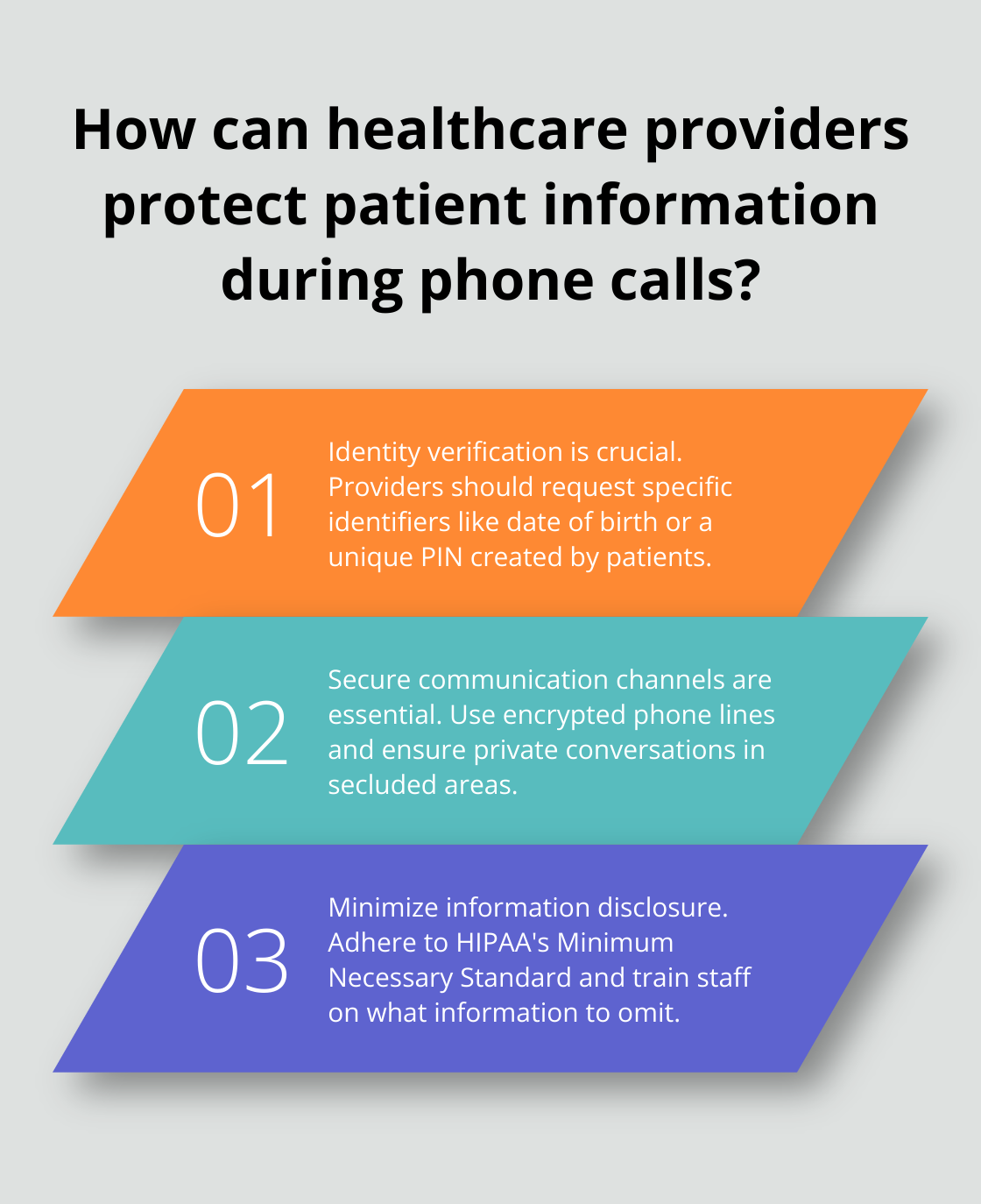
Consider role-playing exercises to help staff practice these skills in a safe environment. Regular refresher courses keep HIPAA compliance at the forefront of everyone’s mind.
Use Call Recording and Monitoring
Maintain an audit trail of phone interactions by using call recording software. This not only helps with quality assurance but also provides evidence of HIPAA compliance. Ensure your call recording system is HIPAA-compliant and inform callers that their calls may be recorded for quality and training purposes.
Create a Comprehensive Phone Policy
Develop a detailed phone policy that outlines all procedures for handling patient information over the phone. This policy should include:
- Steps for verifying caller identity
- Guidelines for leaving voicemails
- Procedures for handling requests from family members or other third parties
- Protocol for reporting potential breaches
Regularly review and update this policy to ensure it remains current with the latest HIPAA regulations and best practices.
Protecting patient information during phone calls requires constant vigilance and adaptation to new challenges and technologies. In the next section, we’ll explore how technology solutions can further enhance HIPAA compliance in phone communications.
How Technology Enhances HIPAA Compliance in Phone Communications
Technology plays a pivotal role in maintaining HIPAA compliance during phone communications. Healthcare providers can use various tools and systems to protect patient information and streamline their processes.
Encrypted Phone Systems: The Foundation of Secure Communications
Encrypted phone systems form the backbone of HIPAA-compliant phone communications. These systems use advanced encryption algorithms to protect conversations from interception. When selecting an encrypted phone system, healthcare providers should prioritize features such as end-to-end encryption, secure call routing, and multi-factor authentication. Many providers offer HIPAA-compliant VoIP solutions that integrate with existing healthcare systems.
Call Recording and Archiving: Compliance Meets Quality Assurance
Call recording and archiving software serve two purposes: they ensure HIPAA compliance and improve service quality. These tools allow healthcare providers to keep accurate records of phone interactions (which can prove invaluable in case of disputes or audits).
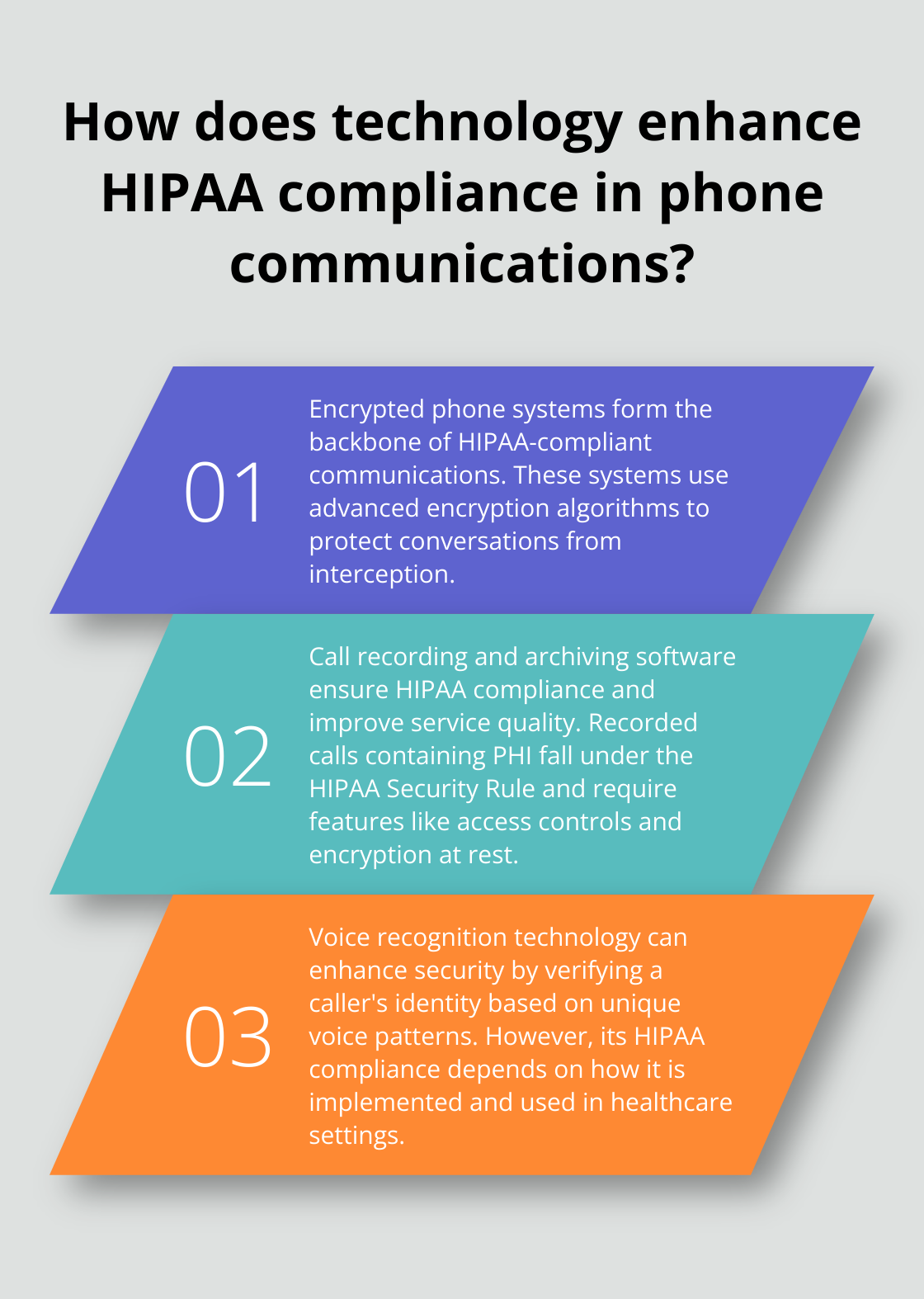
It’s important to note that recorded calls containing Protected Health Information (PHI) fall under the HIPAA Security Rule. Healthcare providers must ensure their call recording system includes features like access controls, encryption at rest, and secure storage.
Voice Recognition and Authentication: Security and Efficiency Combined
Voice recognition technology, in itself, is not inherently HIPAA compliant. Compliance depends on how the technology is implemented and used in healthcare. These systems verify a caller’s identity based on their unique voice patterns, which reduces the risk of unauthorized access to patient information.
Medical Transcription Software: Streamlined Documentation
Medical transcription software helps maintain HIPAA compliance by accurately documenting phone conversations. These tools can transcribe calls in real-time, which allows healthcare providers to focus on the conversation rather than note-taking.
When choosing medical transcription software, healthcare providers should look for features like automatic PHI redaction, customizable templates, and integration with electronic health record (EHR) systems. These features can significantly streamline workflows while maintaining HIPAA compliance.
ScribeJoy stands out as a top choice in this category. It offers AI-powered transcription with human verification, ensuring over 99% accuracy in medical documentation. This level of precision is essential for maintaining HIPAA compliance and providing high-quality patient care.
Final Thoughts
HIPAA compliance for phone calls requires a multi-faceted approach. Healthcare providers must implement rigorous identity verification, use secure communication channels, and minimize information disclosure to reduce privacy breach risks. Comprehensive staff training and detailed phone policies ensure all team members understand and follow HIPAA regulations.
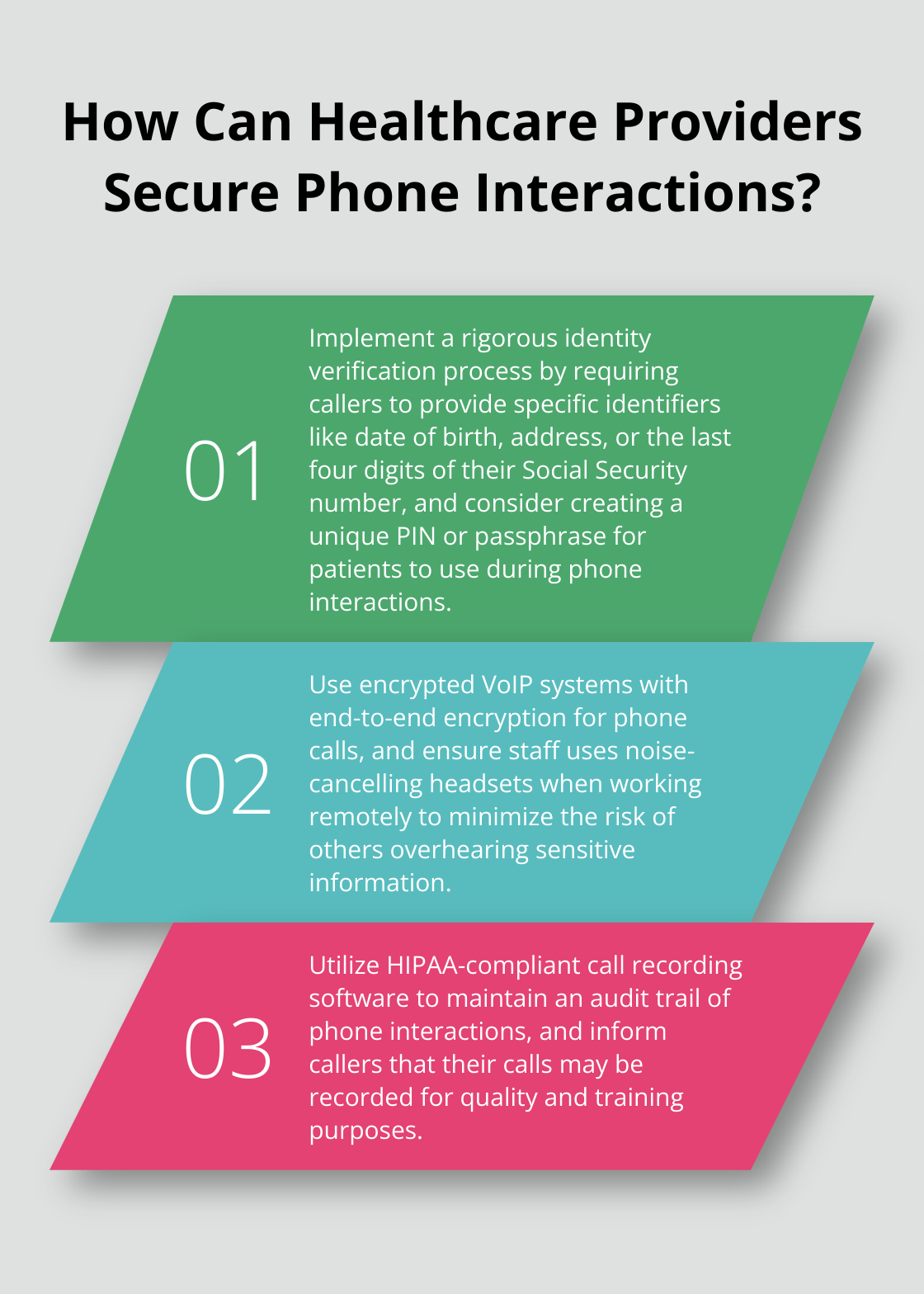
Technology enhances HIPAA compliance in phone communications. Encrypted phone systems, call recording software, and voice recognition tools create a secure environment that protects patient information and improves efficiency. Medical transcription software (like ScribeJoy) offers AI-powered transcription with human verification, ensuring high accuracy in medical documentation.
Healthcare providers must stay updated on the latest HIPAA regulations and best practices. Regular training sessions and technology updates address new challenges and maintain compliance. Leveraging advanced tools and implementing robust policies allows healthcare providers to keep phone communications HIPAA compliant while delivering efficient patient care.
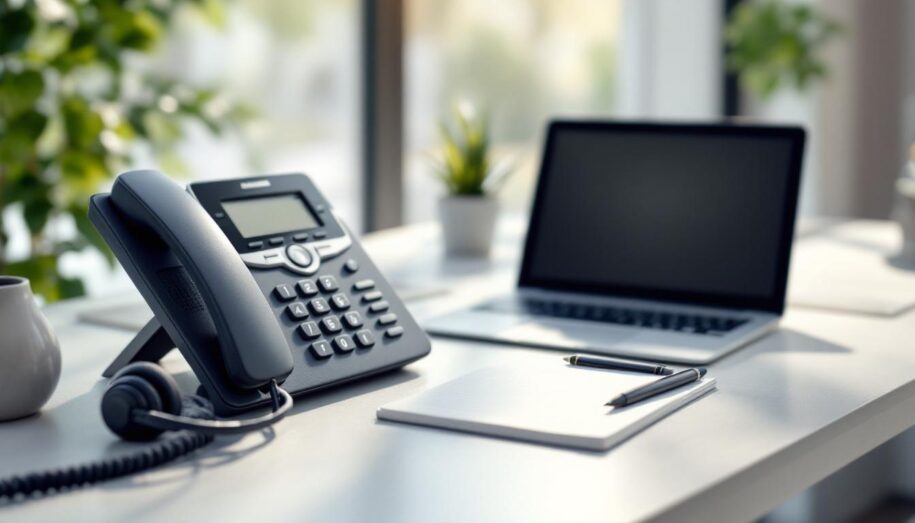
Leave a Reply
You must be logged in to post a comment.